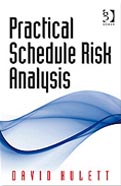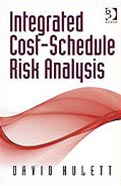Approach to
Project Risk Analysis
and Management
By David Hulett
Every project is important and every project has risk.
Every hour and every dollar are the keys to each successful project. Making good decisions that take account of real-world uncertainties can provide a margin of safety and profit.
Project risk analysis is the identification and quantification of the likelihood and impact of events that may damage the project.
Project managers who assess the risk that the project will overrun its cost estimate or schedule, or will fail to meet performance objectives or specifications often improve their likelihood of a successful project.
Risk analysis is an opportunity to help solve problems and to enhance communications within the project for a more effective team effort. The expertise and knowledge about the project resides in the client's personnel. The added ingredient needed is experience in:
- Structuring the project risk problem
- Disciplined, proven methodologies needed to analyze the risk
- Developing information and data needed to resolve the problem
- Software to put the two together for efficient and effective analysis and handling of project risk
Techniques and tools are available that make risk analysis easier.
Project risk analysis should be installed as a permanent system, a discipline as important to project success as critical path scheduling or cost estimating. Risk analysis and management techniques enable the project manager to:
- Assess the likelihood of meeting or overrunning project objectives
- Calibrate the size of a cost or schedule contingency
- Identify the sources of most risk in complex projects
- Evaluate the benefits and costs of risk management strategies
- Monitor changes in risk of the project
Risk analysis improves the accuracy of traditional scheduling, cost estimation, spreadsheet financial models, and systems engineering skills.
It injects more realism (and sometimes honesty) than can be accommodated in these deterministic techniques. Risk analysis and management is a complete system including:
- Techniques, methods, concepts and available software needed to do the analysis, and
- Tools to address issues including a corporate culture that may not welcome an honest appraisal of risk ("risk is bad news") and people who feel they cannot use judgment to make statements about the future.
A complete system of risk management includes people, attitudes and institutions as well as theory, concepts, hardware and software. An approach that has been effective in helping companies and governmental agencies deal with project risk includes:
- Consulting, usually as a member of the team
- Training in risk concepts and implementation
- Information exchange


